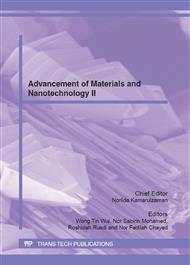p.285
p.290
p.294
p.303
p.308
p.312
p.317
p.321
p.325
Studies of MEH-PPV and MEH-PPV/MCMB Films and their Light Absorption in the Red Wavelength Region of the Visible Spectrum
Abstract:
Poly [2-methoxy, 5-(2-ethyl-hexyloxy)-p-phenylene-vinylene] (MEH-PPV) is a conjugated polymer that exhibit excellent luminescence properties in the visible spectrum. The fundamental absorption edge in the film is formed by the direct allowed transitions. In this work, free-standing films of MEH-PPV and MEH-PPV/MCMB were obtained by a solvent casting method. Mesocarbon Microbead (MCMB), a type of carbon, is added to the polymer producing composite films. The films were characterized by using the UV-Vis-NIR spectrophotometer. The film samples exhibited an absorption band in the red visible region. This is due to the electron transition between the non-localized bands. However, when MCMB is doped into the polymer matrix, the band absorption edge is red-shifted compared to that of the MEH-PPV pure film. Therefore, the optical band gaps of the composite films have decreased due to the presence of MCMB.
Info:
Periodical:
Pages:
308-311
Citation:
Online since:
July 2012
Keywords:
Price:
Сopyright:
© 2012 Trans Tech Publications Ltd. All Rights Reserved
Share:
Citation:


